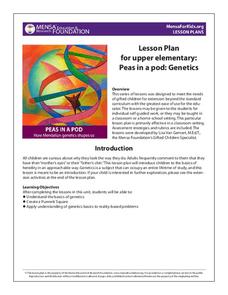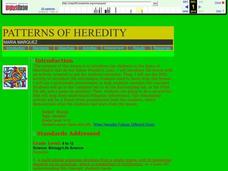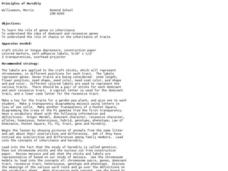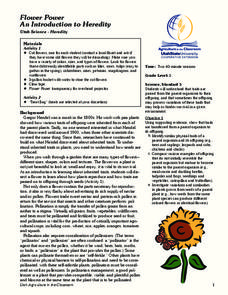Science 4 Inquiry
Monster Mash-Up of Genetics
It's alive! Young mad scientists create monsters as they explore the probabilities of genetic traits during a well-structured inquiry activity. Pairs travel from station to station, rolling the dice and adding traits to their creations...
MENSA Education & Research Foundation
Peas in a Pod: Genetics
Can peas have grandparents? Learn about inherited traits and heredity with a set of activities focused on Mendelian genetics. As your class learns about the process of passing traits along in Punnett squares, they take on the role of...
Curated OER
Mendel Pea Plants
In this Mendelian genetics learning exercise, students answer a variety of questions about Mendel's experiments and discoveries and they practice determining probability of outcomes in pea plants.
Curated OER
Patterns of Heredity
High schoolers describe the differences between incomplete dominance and codominant alleles, and between multiple alleles and polygenic inheritance. They describe how internal and external environments affect gene expression. They then...
Curated OER
Principles of Heredity
Students model traits on genes using colored paper and tongue depressors to represent chromosomes. For this heredity lesson plan, students use their "chromosome sticks" to understand chromosome pairs, genes, dominant traits, recessive...
Curated OER
Cell Reproduction and Inheritance
Students determine their inherited characteristics from their parents. In this biology instructional activity, students study the life of Mendel using an interactive website. They differentiate dominant and recessive characteristics.
Curated OER
Flower Power: An Introduction to Heredity
Learners observe flowers and how they grow according to heredity. In this flowers lesson plan, students observe physical traits that make flowers the offspring of other flowers, and fill out worksheets according to their findings.
Alabama Learning Exchange
Alex: Genetic Babies
Students will explore Gregor Mendel's laws of genetics in this lesson. Students will be paired in male and female groups. If girls and boys can't be evenly divided, same sex students can be paired to represent research scientists....







